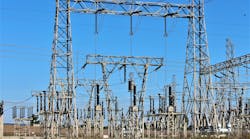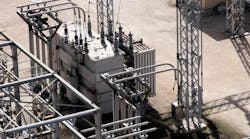A New Natural Gas-Fired Plant was Targeted for Commercial Startup in November. In planning for this load, and a worst-case double-outage contingency, the peak capacity requirement on one of the major 230-kV lines increased to 1500 A — 40% greater than the existing line capacity. Designers were scrambling for a solution that could be delivered within the 10-month project schedule. Bonneville Power Administration (BPA; Vancouver, Washington, U.S.) transmission engineers were trying to figure out how to comply with new, more stringent North American Electric Reliability Corp. outage requirements and integrate new power generation into their grid.
Although now operated at 230 kV, the original line was designed for 287 kV with additional insulation and, most importantly, more ground clearances than BPA's normal 230-kV lines. Built in 1939, the line was never designed for the 347°F (175°C) conductor temperatures that 1500 A could produce on the existing conductor. Preliminary engineering indicated a conductor upgrade with high-temperature aluminum-conductor steel supported (ACSS) would provide the needed capacity. It would also allow the existing lattice-steel towers to be reused. The downside was that the full estimate for the conductor upgrade was approximately US$6 million and having the line operational in the required time would be tight.
THE DECISION TO SHUNT
Clearances appeared generous in the ACSS design, so BPA performed a high-temperature analysis on the existing Drake (795 kcmil, 26/7 aluminum-conductor steel reinforced [ACSR]) conductor to determine the highest operating temperature possible without any impaired clearances. With the existing conductor analyzed at 347°F, no clearance impairments were found. No re-tensioning of conductor was necessary to reach National Electrical Safety Code (NESC) clearances with a 98% assurance level.
Given adequate clearances on the existing line at 347°F, two other major issues arose for line operation at this new high temperature. First, annealing of the aluminum conductor at this temperature would cause loss of strength. Second, the vintage conductor compression connectors would age rapidly at such elevated operating temperatures and provide a significant risk of failure.
Drake conductor contains a relatively large steel core with a rated breaking strength of 19,000 lbs (84.5 kN) at 1% strain, which is typical for ACSR conductors. BPA's loading, which exceeds NESC heavy loading, includes an ultimate load of 1-inch (25-mm) radial ice, 56-mph (90-kmph) wind at 0°F (-18°C). The support load needed for this line was 18,000 lbs (80.1 kN) at ultimate load, which is within the core strength of Drake conductor. Even with some annealing and loss of strength, which affects the aluminum strands, the overall strength of the Drake conductor would exceed the requirements needed for this application.
The compression connectors then became the major focus of the upgrade. How would the aging effects of high-temperature operation be mitigated? The full-tension compression splices and deadends connect conductor sections to form each continuous phase of the transmission line. A shunt would provide a parallel current path to prevent the connector from experiencing the heating that would accompany having to carry full line current. This would prevent the rapid aging and failure from occurring.
Shunting involves cleaning conductor, applying inhibitor and wrapping preformed aluminum wires over conductor sections adjacent to compression connectors. The shunt has an expanded center section and “legs” that wrap on the conductor on either side of the compression connector. The shunt provides a parallel path for line current to reduce the current through the compression connector. The shunt conducts most of the current, so only a fraction of the current flows through the connector. Since the connector carries less current, the connector operates at a cooler temperature, and is protected from premature aging and failure.
An alternate type of shunt was used in some locations. The alternate shunt consisted of two line tap clamps, on either side of the connectors, and a conductor jumper connecting the clamps. The wrapped shunts are designed to be used on a single conductor size. The alternate shunt, with two line tap clamps, is used when conductor changes are made within a line. Also, the alternate shunt is used in substations when a shunt connection is needed from a conductor to a substation riser. The line tap clamps can be drilled for the specific conductor or riser sizes allowing needed transitions.
TESTING SHUNT PERFORMANCE
Testing at BPA labs in Vancouver, Washington, showed splice temperatures were lower at 1500 A with a shunt installed than the splice temperature at 910 A without the shunt. Since the present summer normal rating for the line is 1070 A for 212°F (100°C) operation, the installation of shunts will allow high-temperature operation with lower splice temperatures. This extends the life of compression connectors at high temperature, beyond the expected life of the connectors at normal operation without shunts. Shunts lower connector temperatures at any current level in addition to protecting connectors at high temperatures.
Long-term high-temperature cycling at EPRI labs in Charlotte, North Carolina, U.S., has begun and will run for 1000 two-hour cycles at 1500 A. ACSR Drake conductor with connectors will be monitored with and without shunts. Thermal profiles will be recorded at various locations to characterize the long-term performance of the shunt/connector system. The addition of shunts to connectors exhibiting active thermal breakdown also will be examined. Shunts may also stabilize the performance of marginal connectors at high temperatures.
INSTRUMENTATION
Although lines may be designed for high-temperature operation, it is rare that they would operate above 212°F. At BPA, high-temperature scenarios are based on single- or double-contingency outages. At best, these conditions occur extremely rarely, but the capacity is available to survive a multiple-contingency emergency. Normal operation with additional generation sources will raise the everyday loading on the line. To confirm conductor models for normal and high-temperature operation, two instrumentation systems have been installed on this line.
One system uses a camera that samples data from a target within the span to obtain sag data. The span is calibrated so the sag data yields tension values. A weather station measures temperature and humidity, wind speed and direction, rain and solar characteristics. Additional modeling checks for the conductor thermal model will be possible from field data.
A second system uses load-cells installed in deadend assembly hardware to record tension directly. Additional weather instruments will allow redundancy for the weather model and the conductor modeling. As the line reaches high normal temperatures, or if an outage does occur, evaluation and analysis of the sag/tension of the conductor model and the ambient weather conditions will be possible.
ADVANTAGES OF SHUNTS
Shunts have been used as a maintenance tool to mitigate failing connectors in lines that were in danger of causing an outage. BPA has used shunts for inadequate or failing connectors, but the upgrade assumes that the existing connectors are in good condition, and can support ratings up to 212°F. The addition of shunts enables existing connectors to remain in operation on lines that may have to operate continuously above 212°F, or high temperatures.
A preconstruction inspection of the existing connectors indicated the connectors were in good condition. Resistance readings were taken at compression connectors and the adjacent conductor to evaluate the condition of the connectors. Connectors have greater aluminum cross-section than the conductor and should operate cooler than the conductor. Resistance measurements in connectors that are significantly higher than the conductor indicate deteriorating contact area, which leads to thermal and mechanical failure. Good connectors have resistances at or below that of conductors. Shunts prolong the life of good connectors, because they lower the current level across the contact area, which reduces aging effects of the connector.
Shunts are an effective method to supplement the performance of existing connectors, without having to replace all the connectors with high-temperature connectors. Replacement of connectors with high-temperature versions is an option, but shunts wrap easily to existing conductor, and do not require equipment to handle full-line tension. Shunting does not change conductor lengths, so no monitoring of conductor length changes during construction is necessary.
Most shunts are installed using bucket trucks. When they cannot be used for shunt installations within a span, lowering the conductor to the ground from an adjacent suspension tower proved to be the next-best installation alternative. When neither of these options is practical, riding the conductor from an adjacent tower became necessary as a final alternative.
A SUCCESSFUL PROJECT
The budget for the shunt upgrade was $2 million, and the project finished within budget. The outage required has been three weeks, and the bulk of the work was performed with one crew. The reconductor option would have doubled the outage time and required multiple crews. The material-ordering requirements were much simpler than those required to reconductor 20 miles (32 km) of transmission line. Shunt lead times are typically eight weeks, while the lead times for high-temperature conductor and hardware were much longer.
Scoping has begun for a new 500-kV line that will occupy the same corridor as the 230-kV line. With the addition of a new 500-kV line, load imbalances will be reduced in the 230-kV line. The present upgrade minimizes the stranded investment, since other upgrade options or new lines will be available in the future. This upgrade will extend the life of a 68-year-old line with a low present-worth investment.
Len Custer is a civil engineer with 27 years in transmission line design at Bonneville Power Administration. Since graduating with a BSCE degree from the University of Portland, he has worked in various design groups within BPA. Custer is a member of ASCE and IEEE, where he is the vice-chair of the Line Design Working Group in the Towers, Poles and Conductors Subcommittee. [email protected]

